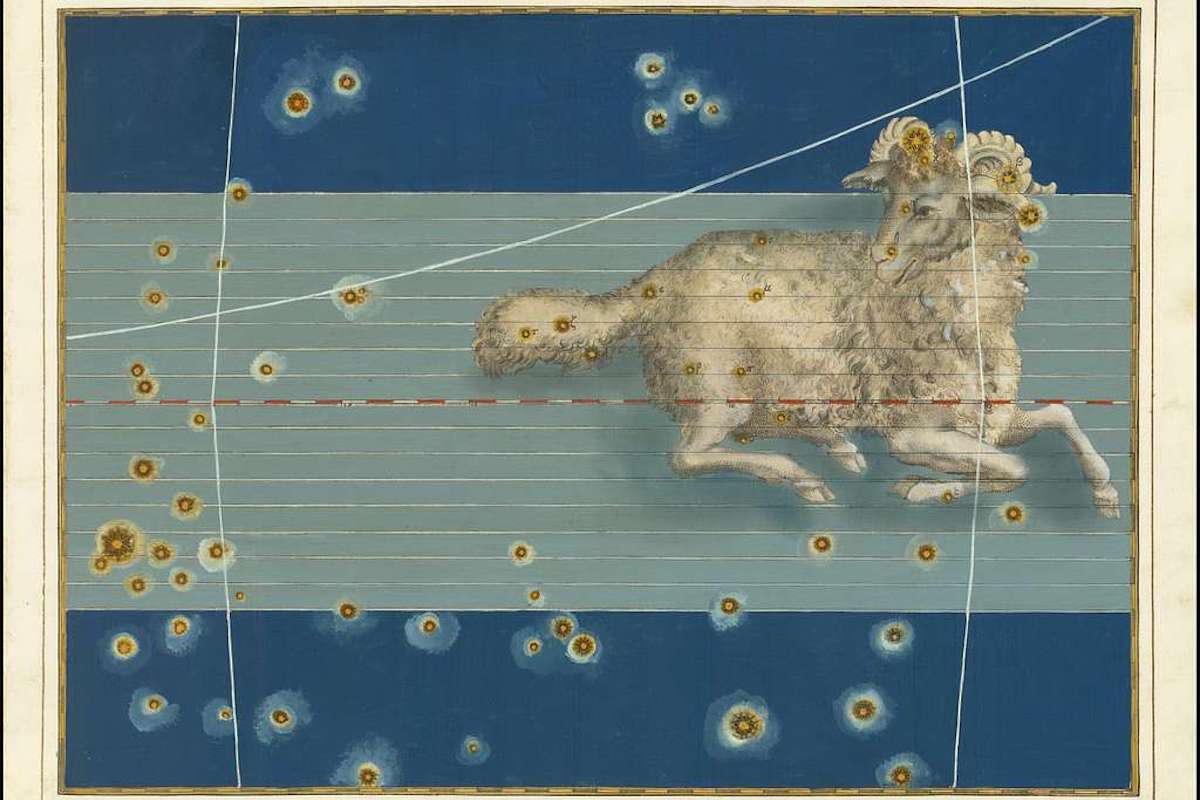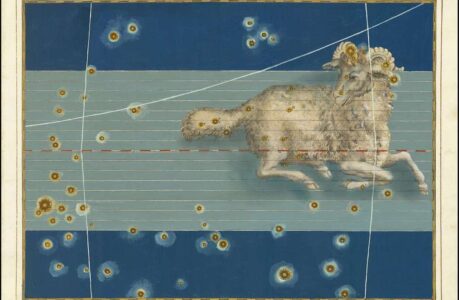If you’re a stargazer in Ireland, you’re in luck: the country offers some of the clearest and darkest skies in Europe, making it an ideal location for observing the night sky. One of the most intriguing constellations you can see from Ireland is Aries, which is known for its bright stars and unique shape. In this article, we’ll take a closer look at the Aries constellation and offer some tips for viewing it from Ireland.
What is the Aries Constellation?
The Aries constellation is one of the 12 zodiac constellations and is located in the northern hemisphere. It is named after the Greek god of war, Ares, and is often depicted as a ram. Aries is located between Pisces to the west and Taurus to the east and is best seen in the months of December through April.
The Aries constellation is known for its bright stars, which make it easy to spot in the night sky. Its most prominent star is Hamal, which is a reddish-orange giant star that is located at the head of the ram. Other notable stars in the Aries constellation include Sheratan, Mesarthim, and Bharani.
Viewing Aries from Ireland
If you want to observe the Aries constellation from Ireland, there are a few things you should keep in mind. First, you’ll need to find a dark and open area that offers an unobstructed view of the night sky. This could be a rural area or a park that is far away from the city lights.
Secondly, it’s important to check the weather forecast before you head out to observe the night sky. Ireland is known for its changeable weather, so it’s best to plan your stargazing trip on a clear night when there is no chance of rain or clouds.
Once you’ve found a good location and the weather is clear, you’ll need to give your eyes time to adjust to the darkness. This can take up to 30 minutes, so be patient and avoid looking at any bright lights, including your phone or flashlight.
When observing the Aries constellation, look for the bright star Hamal at the head of the ram. You should also be able to see the distinctive shape of the constellation, which resembles a diamond or kite. If you have a telescope or binoculars, you may be able to see some of the smaller stars in the constellation.
The Aries constellation is a fascinating sight to observe from Ireland, and with some preparation and patience, you can enjoy this celestial wonder. Remember to find a dark and open area, check the weather forecast, and give your eyes time to adjust to the darkness. With these tips, you’ll be able to appreciate the beauty and wonder of the Aries constellation in all its glory.
The Mythology of Aries
The Aries constellation has a rich mythology that dates back to ancient times. It is said to represent the ram that was sacrificed by the Greek god Zeus in place of his son, who had been taken by pirates. The ram had a golden fleece that was sought after by the hero Jason and his crew in the epic story of Jason and the Argonauts.
In Greek mythology, Aries was also associated with the god of war, Ares, who was known for his fierce and violent nature. Ares was often depicted carrying a spear and wearing a helmet, ready for battle. The association with Ares is why the constellation is named Aries, as it was seen as a symbol of strength and courage.
In other cultures, the Aries constellation also had significant meanings. In ancient Egypt, Aries was associated with the god Amun-Ra, who was the king of the gods and the god of the sun. In Hindu mythology, Aries was associated with the god Brahma, who was the creator of the universe.
The symbolism of the Aries constellation is still relevant today, as it represents the qualities of courage, strength, and leadership. People born under the Aries zodiac sign are said to embody these traits, making them natural leaders and risk-takers. They are also known for their competitive nature and willingness to take on new challenges.
In conclusion, the mythology of Aries is a fascinating blend of ancient stories and beliefs that have been passed down through the ages. Whether you are a stargazer or someone interested in the symbolism of the zodiac signs, the Aries constellation is a captivating sight that is sure to inspire awe and wonder.
The Stars in Aries
The Aries constellation is home to several notable stars, each with its own unique characteristics and properties. Here are some of the stars in Aries:
Hamal is the brightest star in Aries and is located at the head of the ram. It is an orange giant star that is approximately 66 light-years away from Earth. Hamal has a mass that is about twice that of our sun and is thought to be about 5 billion years old.
Sheratan is the second-brightest star in Aries and is located at the ram’s horns. It is a blue-white main-sequence star that is approximately 59 light-years away from Earth. Sheratan is about 2.5 times more massive than our sun and is thought to be around 200 million years old.
Mesarthim is a double star system located in the middle of the Aries constellation. It is composed of two blue-white stars that orbit each other every 88 years. Mesarthim is approximately 203 light-years away from Earth and is thought to be around 400 million years old.
Bharani is a red giant star located in the eastern part of the Aries constellation. It is approximately 160 light-years away from Earth and is thought to be around 200 million years old. Bharani is around 8 times more massive than our sun and has a diameter that is approximately 47 times larger.
41 Arietis is a triple star system located in the southern part of the Aries constellation. It is composed of three stars that orbit each other every 25.5 years. 41 Arietis is approximately 240 light-years away from Earth and is thought to be around 200 million years old.
In addition to these notable stars, there are several other stars and star systems located within the Aries constellation. Studying these stars can give astronomers a better understanding of the composition and properties of the universe as a whole.
Deep Sky Objects in Aries
The Aries constellation is home to several fascinating deep-sky objects that are popular among stargazers and astronomers. Here are some of the most notable deep-sky objects in Aries:
NGC 772 is a beautiful spiral galaxy located approximately 130 million light-years away from Earth. It is notable for its large size, with a diameter of around 200,000 light-years. NGC 772 is also known for its bright core and spiral arms, which are filled with gas and dust.
NGC 697 is an open star cluster located approximately 4,000 light-years away from Earth. It is composed of around 20 stars, including several bright blue giants. NGC 697 is notable for its irregular shape and is a popular target for astrophotographers.
NGC 972 is a barred spiral galaxy located approximately 70 million light-years away from Earth. It is notable for its bright central bar and spiral arms, which are filled with young stars and gas clouds. NGC 972 is also home to several star-forming regions, where new stars are born.
NGC 1023 is a large barred spiral galaxy located approximately 60 million light-years away from Earth. It is notable for its bright central bar and spiral arms, which are filled with gas and dust. NGC 1023 is also home to several star clusters and star-forming regions.
NGC 1156 is a dwarf irregular galaxy located approximately 2.5 million light-years away from Earth. It is notable for its irregular shape and its bright blue stars, which are young and hot. NGC 1156 is a popular target for amateur astronomers due to its relative proximity to Earth.
Observing these deep-sky objects in Aries requires a telescope with a large aperture and a dark observing site. However, they are well worth the effort, as they offer a glimpse into the vast and beautiful universe beyond our own solar system.
When is Aries visible from Ireland
Aries is visible from Ireland during the fall and winter months, from September to April. During this time, Aries rises in the eastern sky in the early evening and sets in the west in the early morning. The best time to observe Aries is during the months of December through April when the constellation is highest in the sky and the nights are longer. However, visibility of Aries can also be affected by weather conditions, light pollution, and other factors that may impact the clarity of the night sky. Therefore, it is always a good idea to check weather forecasts and plan your stargazing sessions on clear, dark nights away from city lights to maximize your chances of observing the Aries constellation.

